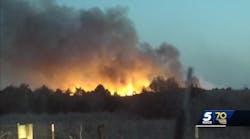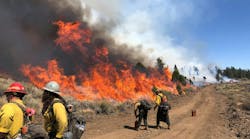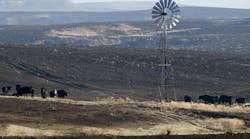CANBERRA, AUSTRALIA—Bushfires in eastern Australia, especially in the country's most populous state of New South Wales (NSW), are continuing to burn relentlessly, with little respite for firefighters despite the milder weather conditions.
They started early this season in spring, instead of around December in the Australian summer, and come against the backdrop of a crippling drought.
The bushfires wiped out most of the homes in the small village of Balmoral, south-west of Sydney, striking the area twice between Thursday and Saturday.
"We've got the devastating news there's not much left in the town of Balmoral," NSW Premier Gladys Berejiklian said on Sunday. Balmoral has around 150 houses and some 400 people.
On Thursday, she had announced a week-long state of emergency, the second in less than two months, due to the extreme heatwave. That night, two young fathers died while fighting the same out-of-control, fast-moving bushfire that destroyed Balmoral.
They were trying to save neighbouring Buxton. Both villages were threatened by the Green Wattle Creek fire, which is one of the two major bushfires near Sydney.
The other one is the Gospers Mountain "megafire," which started in October and has already burned more than 450,000 hectares, including a quarter of a world-heritage listed forest. There are fears that the two big fires burning from the north-west to the south-west of Sydney will join together.
Authorities fear dozens of homes may have been lost on Saturday.
"We have seen widespread damage and destruction being reported across a number of those fire grounds," Shane Fitzsimmons, the head of Rural Fire Service (RFS), told reporters in Sydney on Sunday.
"We still have an enormous amount of fire burning in the landscape."
The milder weather conditions on Sunday did not provide much reprieve as some 110 bushfires continued to burn, keeping hundreds of tired firefighters extremely busy just ahead of Christmas.
"Conditions are particularly dry and fire behaviour continues to be very challenging for firefighters and those areas affected," Fitzsimmons said.
"We're not expecting any meaningful rain to start bringing a meaningful easing of conditions on these fire grounds until late January or early February," he said.
Prime Minister Scott Morrison emphasized the point on Sunday, saying that the firefighters were facing the risk of "terrible fatigue."
The political pressure on the premier has increased after he went on holiday to Hawaii with his family while the blazes continued to burn. He was forced to cut short his trip, and apologized on his return for any "upset" and "anxiety" he had caused.
"The timing is just bad. He made a mistake. I hope he can recover by being proactive on bushfires," said David Brown, a tradesman in Canberra who voted for Morrison.
There are some 210,000 rural firefighters across the country. More than 95 per cent of those are volunteers and many of them have been fighting the bushfire since September.
One of them is Brigitte Lewis, a 50-year-old operating room nurse, in Colo Heights, north-west of Sydney. Her home was under threat due to the Gospers Mountain fire until a few weeks ago.
"Situation has gotten better, the danger has passed," Lewis told dpa over the phone on Sunday. "But the same fire on the other side is creating havoc."
For the past three months, she has taken time off work due to the bushfire, which burned two homes, 10 properties and several cars in her area. It burned for more than six weeks.
"In Colo Heights, it has all burned. We still have some trees smouldering, but there is no immediate danger," said Lewis, the senior deputy captain of the Colo Heights Rural Fire Brigade.
"Now we are helping every day to fight in other areas. It was a bad day yesterday. My daughter left at 7 am and came back home only at midnight after fighting the fire at Mt Wilson."
Lewis said the "intensity of the drought and having no rain all spring" are the main reason for the "enormity of the devastation due to bushfires."
So far in NSW alone, about three million hectares of land has already burned, which is about the size of Belgium.
Eight people have died and about 800 homes have been destroyed and several hundred others damaged. At least 2,000 koalas have died, along with much other wildlife.
"The wildlife and the eagles flying above seem like they don’t recognize where their homes are. It is tragic to watch," Lewis said.
———
©2019 Deutsche Presse-Agentur GmbH (Hamburg, Germany)
Visit Deutsche Presse-Agentur GmbH (Hamburg, Germany) at www.dpa.de/English.82.0.html
Distributed by Tribune Content Agency, LLC.






